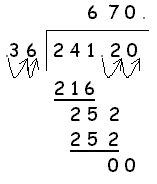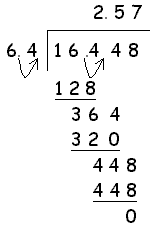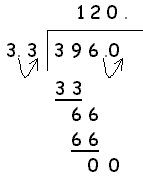Let's first review the names given to the numbers involved in a division problem:
- Divisor - the number you are dividing by
- Dividend - the number you are dividing into
- Quotient - the answer in a division problem
To divide a decimal by a whole number:
- Write the decimal point in the quotient directly above the decimal point in the divisor.
- Divide the numbers as if they were whole numbers.
Examples:
| 1. |
3.75 ¸ 25 |
|
Explanation: |
|
.15
25 ç3.75
2 50
1 25
1 25
0 |
|
Write the decimal point in the quotient directly above the decimal in the dividend.
Divide as if the numbers were whole numbers.
|
2. |
.396 ¸ 9 |
|
Explanation: |
|
.044
9 ç.396
360
36
36
0 |
|
Write the decimal point in the quotient directly above the decimal in the dividend.
Divide as if the numbers were whole numbers.
9 does not go into 3, so we must use a zero as a placeholder directly after the decimal. |
It is very important that you write the decimal in the quotient directly above the decimal in the dividend.
To divide by a decimal, multiply the divisor by 10, 100, 1000, and so on, until the divisor is a whole number. Then multiply the dividend by the same number. Multiplying by 10 moves the decimal one place to the right. Multiplying by 100 moves the decimal two places to the right, and so on.
To divide by a decimal:
- Move the decimal point in the divisor to the right until a whole number is obtained.
- Move the decimal in the dividend the same number of places to the right.
- Write the decimal in the quotient directly above the decimal in the dividend.
- Divide the numbers as if they were whole numbers.
Examples:
| 1. |
7.6 ¸ .05 |
Explanation: |
|

|
Move the decimal in the divisor two places to the right to make the divisor the whole number 5.
Move the decimal in the dividend two places to the right.
Add one zero to the dividend so the decimal can be moved two places.
Place the decimal in the quotient directly above the decimal in the dividend.
Divide as if the numbers were whole numbers.
|
2. |
241.2 ¸ .36 |
Explanation: |
|

|
Move the decimal in the divisor two places to the right to make the divisor a whole number 36.
Move the decimal in the dividend two places to the right.
Add one zero to the dividend so the decimal can be moved two places.
Place the decimal in the quotient directly above the decimal in the dividend.
Divide the numbers as if they were whole numbers.
Add zero after the seven in the quotient as a placeholder. |
The zero in Example #2 is another reason why you must place the decimal in the quotient directly above the decimal in the divisor.
Also, the zero in Example #2 is a reminder that you must place the first answer in your quotient in the correct position. 36 goes into 241, so the 6 goes directly above the 1 in the dividend.
| 3. |
16.448 ¸ 6.4 |
Explanation: |
|

|
Move the decimal in the divisor one place to the right to make the divisor a whole number 64.
Move the decimal in the dividend one place to the right.
Place the decimal in the quotient directly above the decimal in the dividend.
Divide the numbers as if they were whole numbers.
|
4. |
396 ¸ 3.3 |
Explanation: |
|

|
Move the decimal in the divisor one place to the right to make the divisor a whole number 33.
Place a decimal after 396 to make a decimal number 396.
Move the decimal one place to the right in the dividend and add a zero.
Place the decimal in the quotient directly above the decimal in the dividend.
Divide the numbers as if they were whole numbers.
|